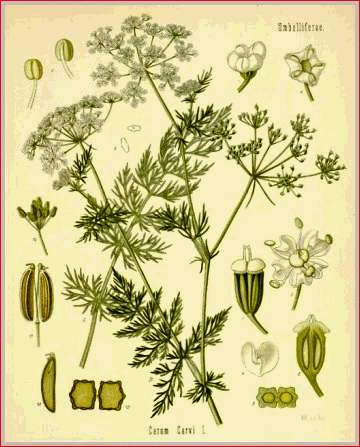
CARUM. U. S. (Br.) CARAWAY [Carawayseed, Caraway Seed CARUM.
U. S. (Br.) CARAWAY
CARUM.
U. S. (Br.) CARAWAY
United States Dispensatory 1926.
Compiled and edited by Ivor Hughes
" Caraway is the dried ripe fruit of Carum Carvi Linne (Fam.
Umbelliferae). Caraway contains not more than 3 per cent, of other fruits,
seeds or foreign organic matter, and yields not more than 1.5 per cent, of
acid insoluble ash." U. S
"Caraway Fruit is the dried ripe fruit of Carum Carvi, Linn." Br.
Carul Fructus, Br.; Caraway Fruit; Carvies, Cumin des Pr�s, Carvi, Fr.; Fructus Carvi, P. G.; Gemeiner Kűmmel, Kűmmel, Garbe, G.
The caraway plant is a biennial herb with a spindle-shaped, fleshy, whitish root from which arises, during the first year, a cluster of bi- to tripinnate leaves. During the second year there arises a slender stem bearing alternate, pinnate to bipinnate leaves, the terminal segments of which are very narrow and pointed. The inflorescence is a long-stalked, compound umbel bearing small white flowers with five minute calyx teeth, five ovate and notched petals, five stamens and a conical stylopod. The fruits are oblong; laterally compressed dark-brown cremocarps.
It is a native of Europe and Asia, growing wild in meadows and pastures, and cultivated in many places. The flowers appear in May and June, and the seeds which are not perfected until the second year, ripen in August. The root, when improved by culture, resembles the parsnip, and is used as food in Northern Europe.
Caraway has been cultivated in Germany, Holland, Morocco, Spain, Norway, Russia, England and to a lesser extent in the northern part of the United States. The plant thrives well in clay soil containing some humus. The plants are mowed down when the oldest fruits are ripe, dried in the field or in the barn loft until they have lost most of their moisture, after which the fruits are thrashed out, cleaned and stored in bags. Most of the commercial supply used by this country comes from Holland in burlap bags.
Description and Physical Properties. � " Unground Caraway. � Usually in separated mericarps; curved, tapering towards both ends; up to 7 mm. in length and 2 mm. in diameter; externally dark brown with five yellow filiform ribs; odor and taste aromatic.
"Structure. � Mericarps nearly equilaterally pentagonal, with a fibro-vascular bundle in each rib; outer epidermis of tangentially-elongated, rather thick-walled cells, a middle layer of collapsed parenchyma bearing the oil tubes, usually six in number, sometimes one or more additional, and located between the ribs; an inner epidermis of broad parenchyma cells, more or less collapsed and which are coherent with the collapsed cells of the seed coat; endosperm of thick-walled parenchyma containing fixed oil and aleurone grains up to 0.010 mm. in diameter and in which are embedded rosette aggregates of calcium oxalate up to 0.004 mm. in diameter. " Powdered Caraway. � Elements of identification are the outer epidermal cells characterized by a waviness and stripping of the cuticle; the cells of the endosperm containing aleurone grains with the embedded rosette aggregates; trache; lignified fibers and fragments of the oil tubes." U.S.
" Mericarps usually separate; each from about four to six millimetres long and about one millimetre broad; brown with paler primary ridges; slightly curved, tapering towards each end, and glabrous. In transverse section, six vittea in each mericarp. Odor and taste aromatic. Ash not more than 9 per cent." Br.
They have an agreeable aromatic odor, and a sweetish, warm, spicy taste. These properties depend on an essential oil, which they afford largely by distillation. (See Oleum Cari.) The residue is insipid.
"Drawn caraway seeds," a term applied to such as have been recovered from the still residue after obtaining the volatile oil, are used to adulterate caraway; the exhausted "seeds" are much darker in color than are the genuine and are less odorous. (P. J., 1896,150.) While this is the principal form of adulteration, they may contain large amounts of stems, gravel, sand, dust, weed seeds and other impurities.
Uses. � Caraway is a pleasant stomachic and carminative, occasionally used in flatulent colic, and as an adjuvant or corrective of other medicines.
The
dose in substance is from fifteen to thirty grains (1-2 Gm.).An infusion may be prepared by adding two drachms of the seeds to a pint of boiling water. The volatile oil, however, is more employed. (See, Oleum Cari.) Three and a half ounces of the oil of caraway caused violent vomiting and abdominal pain, with loss of consciousness, ending, however, in recovery. The urine contained both acetone and albumin. (Cb. I. M., xxii, 1902.) In culinary operations the seeds are added to cakes, to which they communicate an agreeable flavor, while they stimulate the digestive organs.
Dose
, fifteen to thirty grains (1-2 Gm.).Off. Prep. � Aqua Carui, Br,; Confectio Piperis, Br.; Pulvis Opii Compositus, Br.; Tinctura Cardamom! Composita, U. S., Br.; Tinctura Sennae Composita, Br.
Did you find what you were seeking ? If not use the site search box at the top right of the page or else peruse the main site library. If all else fails ask your questions in the site forum.
![]()